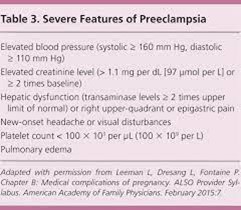A nurse is caring for a client who is at 32 weeks gestation and has a history of hypertension. Which of the following statements by the client should the nurse report to the provider?
"My ankles get swollen after standing at work."
"My gums bleed when I brush my teeth."
"I have constant pain in the middle of my upper abdomen."
"I feel dizzy when I lay flat on my back.
The Correct Answer is C
Choice A rationale:
Ankle swelling can be a common symptom of pregnancy and is not necessarily indicative of a complication.
Choice B rationale:
Gums can become more sensitive during pregnancy, leading to bleeding while brushing teeth. This finding is common and not necessarily indicative of a complication.
Choice C rationale:
Constant pain in the middle of the upper abdomen can be a sign of preeclampsia, a serious pregnancy complication that requires prompt medical attention.
Choice D rationale:
Feeling dizzy when lying flat on the back (supine hypotension) can be a common discomfort during pregnancy due to pressure on the vena cava. However, it does not necessarily indicate a complication in this context.

Nursing Test Bank
Naxlex Comprehensive Predictor Exams
Related Questions
Correct Answer is C
Explanation
Choice A rationale:
A hemoglobin level of 13 g/dL is within the normal range and is not specifically indicative of HELLP syndrome.
Choice B rationale:
A blood urea nitrogen (BUN) level of 8 mg/dL is within the normal range and is not typically associated with HELLP syndrome.
Choice C rationale:
Elevated bilirubin levels are a characteristic feature of HELLP syndrome, which involves liver dysfunction.
Choice D rationale:
A hematocrit level of 38% is within the normal range and is not specifically indicative of HELLP syndrome.
Correct Answer is B
Explanation
Choice A rationale:
A fasting blood glucose level of 96 mg/dL is within a normal range and is not typically associated with carbidopa/levodopa therapy.
Choice B rationale:
Hemoglobin levels of 10 g/dL may indicate anemia, which can exacerbate symptoms in clients with Parkinson's disease and affect the effectiveness of carbidopa/levodopa.
Choice C rationale:
A platelet count of 200,000/mm3 is within a normal range and is not typically associated with carbidopa/levodopa therapy.
Choice D rationale:
A blood urea nitrogen (BUN) level of 10 mg/dL is within a normal range and is not typically associated with carbidopa/levodopa therapy.
Whether you are a student looking to ace your exams or a practicing nurse seeking to enhance your expertise , our nursing education contents will empower you with the confidence and competence to make a difference in the lives of patients and become a respected leader in the healthcare field.
Visit Naxlex, invest in your future and unlock endless possibilities with our unparalleled nursing education contents today
Report Wrong Answer on the Current Question
Do you disagree with the answer? If yes, what is your expected answer? Explain.
Kindly be descriptive with the issue you are facing.
